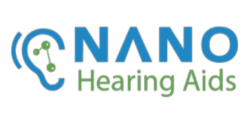- Offers CIC or BTE-style hearing devices
- History of misleading marketing practices
- Many negative reviews regarding sound quality and returns process
Nano Hearing Aids Review 2025: Consider Alternative Options
Key Takeaways
- Nano hearing aids is an online OTC hearing aid retailer offering low-cost completely-in-canal (CIC) and behind-the-ear (BTE) hearing aid styles for mild to moderate hearing loss.
- Nano hearing aids cost between $297–$597 per pair, depending on the model.
- Although the brand advertises high-tech features, a recent government lawsuit claimed the company has a history of misleading marketing practices.
Now that over-the-counter (OTC) hearing aids are approved for sale to the public, a lot of new hearing aid brands have entered the market, many at prices that are within reach for more Americans than ever before. And prices are expected to get even lower as competition grows. Our team has found some low-cost brands to be quite reliable, while others—not so much. With so many new low-cost hearing aids flooding the market, how do you know which brand you can trust?
We researched one low-cost brand, Nano, to help you understand what the company offers compared to other OTC hearing aid brands. In this Nano hearing aids review, we’ll tell you what to look for and what to ask before you buy a pair of Nano hearing aids.
Nano hearing aids may seem to be an affordable option for many, promising high tech features that will improve lives. But a recent lawsuit and further research into the brand revealed the company’s claims may not be fully legitimate. Keep reading to find out why our team doesn’t recommend Nano hearing aids. You can learn more about how to spot unreliable hearing aid brands in our article, how to avoid OTC hearing aid scams.
Why you can trust our expert review
Our team recommends products and services that we believe provide value in the lives of our readers. We’ve spent more than 5,000 hours conducting in-depth research on hearing aid devices to give you the most accurate hearing aid review. To make these selections, we:
- Consulted with audiologists
- Mystery shopped 18 brands
- Surveyed hundreds of hearing aid users
- Tested various models of hearing aids
- Interviewed experts in the field
- Read thousands of verified customer reviews
Read more about our hearing aid review methodology.
About Nano hearing aids
Nano is a hearing technology company based in Phoenix, Arizona. The brand claims to offer hearing aid models at a fraction of the competitor’s cost, although a recent lawsuit argued otherwise.
In November 2022, the Vermont Attorney General filed a complaint against Nano, claiming the brand sold unauthorized products to hundreds of Vermont citizens. The documents accuse Nano of falsely advertising its hearing products as hearing aids when they are actually personal sound amplification products (PSAPs). PSAPs are devices that amplify all sounds for people with normal hearing and are not intended for those with hearing loss, according to the Food and Drug Administration (FDA).1
Other accusations claimed Nano marketed its products as FDA approved when they were not, among other misleading marketing practices listed in the full report (PDF).2 Nano hearing aids is registered with the FDA, which means the company has filed paperwork annually and appears in the FDA database. Approval can only be granted after the FDA has reviewed the product and determined its safety, quality, and effectiveness for medical use.
Because of recent allegations and other factors listed in this review, our team does not recommend Nano hearing aids. We also recommend talking to your hearing care professional and referring to our best OTC hearing aids article for better and more affordable alternatives. In addition, see section titled “Four Reputable Alternatives to Nano” at the end of this review.
Pros and cons of Nano hearing aids
Table 1 Comparison of Nano hearing aids, as of 2025
| NANO CIC Recharge | NANO CIC Digital Recharge | NANO X2 Recharge | NANO Sigma Plus Bluetooth | |
|---|---|---|---|---|
| Cost (per pair) | $297 | $397 | $497 | $597 |
| Style | CIC | CIC | BTE | BTE |
| Degree of hearing loss | Mild to moderate | Mild to moderate | Mild to moderate | Mild to moderate |
| Battery | Rechargeable | Rechargeable | Rechargeable | Rechargeable |
| Bluetooth | No | No | No | Yes, but no streaming |
| Customization | No | No | No | No |
| Water resistant | No | No | No | No |
| Telecoil | No | No | No | No |
| Directional microphone | No | No | Yes | Yes |
| Noise reduction | No | Yes | Yes | Yes |
| Processing channels | 4 | 4 | 4 | 4 |
Nano hearing aid model reviews
Nano CIC Recharge
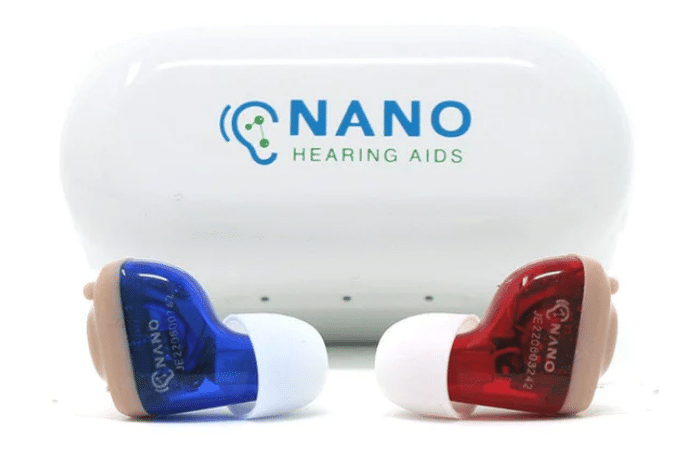
- Cost: $297
- Dimensions: 17.2 x 15 x 12.1 (height x length x width) millimeters (mm)
- Weight per hearing aid: 0.9 grams (g)
- Type of hearing device: CIC
- Degree of hearing loss: Mild to moderate
- Battery type: Rechargeable
- Bluetooth: None
Nano CIC Recharge hearing aids fit discreetly in your ear canal and last up to 60 hours per charge. Each device has push-button manual controls to turn the devices on or off, adjust volume, or switch between programs.
A four-second-long press of the button will turn the device on or off, while tapping the button quickly will switch between six volume settings. Once you reach the loudest volume (level six), another tap will return you to the quietest volume (level one).
Pressing the button for two seconds will activate preset programs or modes, which enhance sound in specific environments. The Nano CIC Recharge offers two modes:
- Normal conversation: Enhances sound in quiet environments, like in the home
- Music listening: Improves sound when listening to music at home or at an event
These hearing aids also offer the following common, basic features:
- Noise reduction: Dampens unwanted noise to clarify important sounds, like speech
- Feedback control: Prevents the annoying whistling that occurs when sound waves leave the receiver and accidentally enter the hearing aid’s microphone
Each pair of Nano CIC Recharge hearing aids comes with a portable charging case that holds up to five on-the-go charges before it needs to be replenished. The portable charging case has its own charging cable and plug, which is also included with your purchase.
The hearing aids come with an accessory kit, which includes three different ear dome ⓘAlso known as a tip, an ear dome is a flexible attachment that fits onto a hearing aid’s receiver to protect the speaker. It also helps the hearing aid fit into the ear canal properly. shapes in three different sizes to make sure the devices fit properly in your ear canal. You also get four wax guards ⓘWax guards prevent ear wax buildup in the hearing aid receiver. Excessive ear wax will clog the receiver and block sound waves from entering your ear. and a wax guard replacement tool to make sure your receiver stays unclogged, and a cleaning brush with a wax loop that removes superficial debris and earwax from the outside of your device.

Nano CIC Digital Recharge
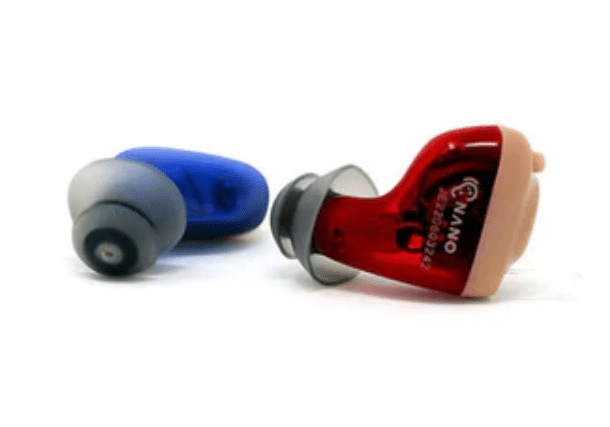
- Cost: $397
- Dimensions: 17.2 H x 15 L x 12.1 W mm
- Weight per hearing aid: 0.9 g
- Type of hearing device: CIC
- Degree of hearing loss: Mild to moderate
- Battery type: Rechargeable
- Bluetooth: None
Similar to the Nano CIC Recharge, the Nano CIC Digital Recharge hearing aids offer a discreet fit, 60 hours of battery life per charge, and push-button controls. They also offer four programs compared to the Nano CIC Recharge’s two. In addition to normal conversation and music listening modes, you get:
- Noisy places: Reduces noise in environments where you’d like to focus on important sounds, like conversations in a restaurant
- Loud places: Improves sound quality in high-volume environments, like traffic or crowds
Expect the same basic features as the Nano CIC Recharge, although customer support told us these hearing aids provide a more enhanced noise reduction feature that manages background noise. This is because these hearing aids are digital, which means they use microchips to process sound into clearer, sharper audio when compared to analog devices, according to the FDA’s definition.3 Most hearing aids these days offer digital sound processing.
Your purchase comes with the same accessories as the Nano CIC Recharge, including the same portable charger and accessories.
Nano X2 Recharge
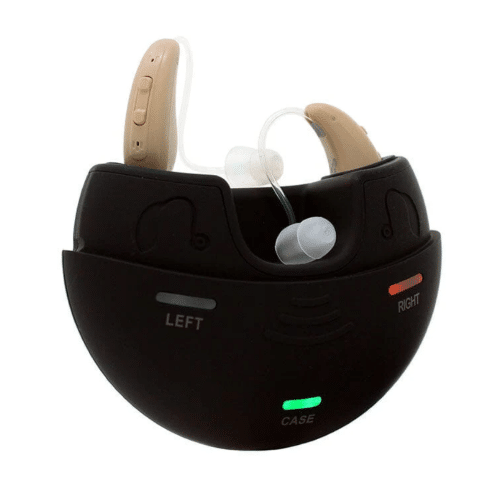
- Cost: $497
- Dimensions: 33.4 H x 8.7 L x 11.7 W mm
- Weight per hearing aid: 2.95 g
- Type of hearing device: BTE
- Degree of hearing loss: Mild to moderate
- Battery type: Rechargeable
- Bluetooth: None
The Nano X2 Recharge hearing aids come in a larger BTE style with less battery life than the Nano CIC hearing aid options. One charge lasts 23 hours, which is still enough to get you through the day.
According to Nano, these hearing aids offer more technology, which may make them more appropriate for someone with mild to moderate hearing loss. Aside from preset programs and noise cancellation, they have:
- Directional microphones: Helps you focus on sound in front of you while drowning out sounds in other directions
- Greater amplification: Increases volume to louder levels than Nano CIC hearing aids
But the same lawsuit filed by Vermont claims Nano X2 hearing aids do not offer the directional microphones the company advertises online.2
Similar to Nano CIC models, you control the hearing aid using buttons on the body of the device. A four-second-long press will turn your device on or off, and you can toggle the button up or down to adjust the volume. Switch between four preset programs by pressing the button for two seconds.
Nano X2 Recharge comes with a portable charging case that holds enough power to replenish your hearing aid batteries three times while on the go. The case is recharged by connecting its charging cable and plugging it into a wall outlet. You also get an accessory kit, complete with three dome shapes of three sizes, two extra receiver tubes that connect the hearing aid to the receiver, and a cleaning brush with a wire to push out debris in the receiver tubes.
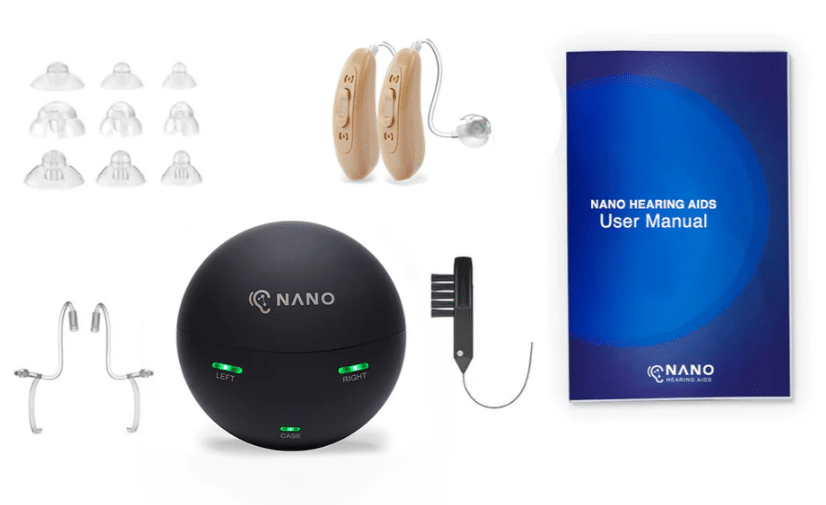
Nano Sigma Plus Bluetooth

- Cost: $597
- Dimensions: 35.7 H x 14.2 L x 8.6 W mm
- Weight per hearing aid: 2.95 g
- Type of hearing device: BTE
- Degree of hearing loss: Mild to moderate
- Battery type: Rechargeable
- Bluetooth: Yes, but no streaming
The Nano Sigma Plus hearing aids are the most costly model the company sells. The Nano’s features are similar to the other models but comes with an additional perk: a mobile app.
The Nano Hearing app is available on the App Store and Google Play. Once you download the app, you’ll receive instructions on how to connect your hearing aids, allowing you to use the app like a wireless remote control for sound adjustments rather than using the manual button controls on the hearing aid itself. But if you prefer manual adjustments, you can still do so using the buttons on the devices.

These hearing aids also have four programs, but they’re slightly different. You still get a conversation program, but the other preset programs enhance sound in restaurant, traffic, and outdoor settings.
Each purchase of Sigma Plus hearing aids comes with a charger and accessory kit that looks similar to the Nano X2 Recharge kit, but with a charging dock instead of a portable charging case. The dock must be plugged into the wall to charge your hearing aids.

Although the Nano Sigma Plus connects to an app via Bluetooth, it does not have Bluetooth features like connecting for phone calls. If this is an important feature for you, learn more from our Bluetooth hearing aid guide.
How much do Nano hearing aids cost?
Nano hearing aids cost between $297–$597 per pair. This includes a charging case and cleaning accessories. The Nano CIC styles are lower in the price range than the BTE styles.
How to buy
This brand only sells its hearing aids online. You can purchase them through the Nano website by adding your desired model to your cart and following the checkout process, which includes entering your contact information, address, and credit card details.
Your purchase comes with free United States Postal Service (USPS) first-class shipping, which takes five to seven days to arrive. For an additional $50, you can choose express shipping and receive your hearing aids in two to three days.
How to pay
Nano accepts all major credit cards: American Express, VISA, Discover, and Mastercard. It also accepts other forms of payment:
Affirm is a credit provider offering plans with varying payments, depending on the model you choose and your approved rate. Be aware that your plan could have up to a 36% annual percentage rate.
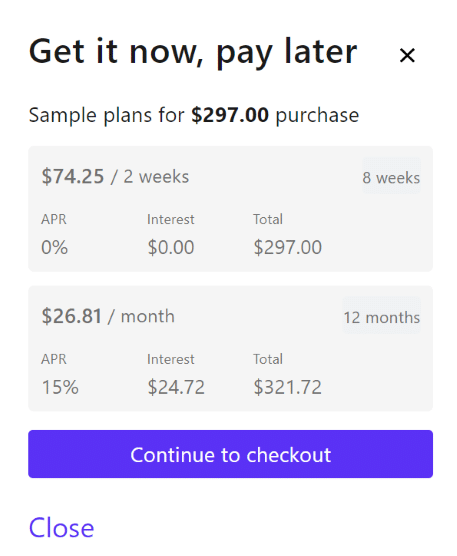
Before you pay, consider asking your insurance company if your plan offers hearing aid coverage.
If you need help paying for hearing aids, consider reaching out to local organizations like the Lions Club, which can lend a hand to those who qualify. And don’t forget to check NCOA BenefitsCheckUp to discover other support you may be eligible for.
Warranty and protection plans
Nano offers a one-year warranty with all of its hearing aids, although this isn’t clearly stated online. Customer support informed us the standard warranty covers manufacturing defects only.
If you want additional coverage, you can purchase a Nano Protection Plan Bundle, which groups the Nano Elite Protection Plan with any model of hearing aid. It lasts one year and is renewable at the end of the term.
The Elite Protection Plan covers all manufacturer defects, including:
- One replacement per device
- Accidental damage repair
- Loss and theft (after a 30% deductible)
- Discounted yearly upgrade
The plan is only valid for the first year of ownership, starting from the day you buy the device. If you need to submit a claim, contact 24/7 support at 619-738-2438 to see if your case qualifies for coverage. You may need to pay for shipping and handling.
Returns
All Nano hearing aids come with a 45-day money-back guarantee. If you need to return your devices, you must do so within the first 45 days of ownership to receive a full refund. If you do not initiate a return within this time period, your device will no longer be eligible for return. You will be responsible for shipping and handling costs when you make your return, even if the returns and exchanges are under warranty.
Note all returns must have a return merchandise authorization number included with the package, so be sure to get this number when you call Nano support to initiate the return.
Accessories
You can purchase additional Nano accessories online through the Nano Hearing Aids website. Accessory kits for all models are available at $19 per package. Accessory kits include a pack of domes, one set of tubes, and one cleaning brush.
If you don’t want to purchase an entire kit, Nano does sell tubing by itself. Unfortunately, the Nano accessory page seems incomplete. The company recommends replacing the receiver tubing every three months, but you can only purchase replacement tubing at $17 per pair for the X2 Recharge model. Also, you can purchase an X2 portable charging case for $149, but chargers for the other models aren’t available online. We asked customer service how someone could purchase supplies for other devices, and they told us you would have to call to order tubing or chargers for the other devices.
Nano also sells zinc-air batteries online for its disposable battery-operated hearing aids. Batteries come in six packs of six for $49.
Customer reviews
Nano Hearing Aids does not have a Better Business Bureau (BBB) rating, but it scores 3.22 out of 5 stars with 539 customer reviews. Nearly all reviews from the previous year are negative, with many customers reporting faulty devices and difficulty receiving refunds.
Nano has 3 out of 5 stars with 813 reviews on Trustpilot. Recent customer reviews are mixed compared to BBB, but negative reviews echo the same concerns regarding faulty hearing aids and difficult returns. Positive reviews describe helpful customer support experiences.
“I had a faulty hearing aid and called about it, and the representative was very nice and understanding. Gave me instructions on what to do and the whole operation was very easy. Only drawback was the barcode label did not have free shipping, so I had to take it to the post office to pay shipping before it would go.”
Marge H., VERIFIED CUSTOMER (Trustpilot)
“The device works pretty good. However, having the on-off/volume/sound menu button at the bottom causes issues while inserting the piece. This causes a lot of feedback. It is also hard to change the volume while in the ear.”
BG, VERIFIED CUSTOMER (Trustpilot)
“The hearing aids I received did not work properly, and when I returned them well within 45 days, I was told that I would receive my refund within two to five days for $796. That was a month ago and still no money. Each time I call them, I get the same message that my money will be returned within two to five days…”
Billy Y., VERIFIED CUSTOMER (BBB)
Customer service
You can contact Nano customer service via phone, online chat, and email.
- Sales: 888-310-6266
- Support: 619-738-2438 available 24/7
- Chat: 24/7 support
- Website: Using the online form
- Email: support@nanohearingaids.com
Our team used customer support frequently during our research due to the lack of information on the Nano website. We were able to contact support consistently through online chat, but some responses took five to 10 minutes, and they did not always answer our questions thoroughly.
Reaching out over the phone had no wait time, but the support agent was curt and seemed to have trouble answering our questions about hearing aid technology, similar to our experience interacting with online chat.
Four reputable alternatives to Nano
If you’re looking for an OTC hearing aid to treat your mild to moderate hearing loss, consider other brands with a better reputation and more transparency regarding their technology.
If you’re purchasing a hearing aid for the first time, be sure to see a hearing professional. Ruth Reisman, audiologist and co-founder of Urban Hearing in Brooklyn, New York, urges people with hearing loss to consult with a professional before purchasing any type of hearing aid. “This would include having a professional look into the ear with an otoscope to make sure there are no contraindications to putting something in the ear, followed by a comprehensive hearing test,” Reisman said.
If your audiologist determines your hearing loss can be improved with a hearing aid, they can help point you in the right direction, toward brands they know to be trustworthy.
All hearing aids listed in the table below are featured in our 13 best hearing aids review and have been tested thoroughly by our team. These hearing aids can be purchased directly from the company, through a hearing care clinic, or through a discount online retailer like Yes Hearing.
Table 2 Comparing Nano to other hearing aid brands, as of 2025
| Brand | Nano | Jabra Enhance | Phonak | MDHearing | Lexie |
|---|---|---|---|---|---|
| Price per pair | $297–$597 | $799–$1,995 | $2,400–$7,000 | $299–$699.98 | $799–$999 |
| OTC or prescription | OTC | OTC | Prescription | OTC | OTC |
| Degrees of hearing loss | Mild to moderate | Mild to moderately severe | Mild to profound | Mild to moderate | Mild to moderate |
| Warranty (years) | One | One to three* | Depends on retailer | One to two* | One |
| Trial period (days) | 45 | 100 | Depends on retailer | 45 | 45 |
*Depends on the hearing aid or package you purchase
1. Jabra Enhance
Jabra Enhance is our “Editor’s Pick” in our best hearing aids roundup because it offers relatively affordable OTC hearing aid options with financing opportunities, one to three-year warranties, and full audiology team support, depending on your package, as well as an industry leading 100-day trial period. All Jabra Enhance hearing aids have Bluetooth connectivity and streaming, which allows you to send audio from your phone or television directly to your ears.
2. A prescription aid, like Phonak
Although Phonak is a prescription hearing aid option, it’s important to consider your hearing loss may require a device with more advanced technology built to treat all types of hearing loss. Prescription hearing aids have higher price points compared to OTC options, but it may be what you need to address your hearing loss appropriately. Visit your local hearing care specialist for a full examination to determine the cause of your hearing loss and which type of hearing aid, if any, is best for you.
3. MDHearing
Perhaps the most comparable hearing aid brand to Nano is MDHearing, which earned our “Most Versatile” pick on our best hearing aids review.
For a similar price range of $299–$699, you can choose between BTE, receiver-in-canal (RIC), and in-the-canal (ITC) styles. The MDHearing VOLT MAX is the brand’s most advanced, Bluetooth-enabled model with mobile app controls and FDA clearance as a self-fitting hearing aid ⓘSelf-fitting hearing aids include software that allows the user to program their own devices., although this does not yet mean the devices are FDA approved. Regardless, FDA clearance is a more trustworthy label than registration, which simply means the company has filed paperwork annually and appears in the FDA database.
4. Lexie
Lexie is one of the highest-rated OTC hearing aids tested by our team, with 5 out of 5 stars. It offers hearing aids with a range of features, including telecoil ⓘA telecoil is a small copper wire (similar to a receiver) built into a hearing aid that allows you to connect to a phone or loop system to bring audio directly to you. Loop systems are commonly found in public facilities, like theaters, places of worship, and on public transportation. and Bluetooth connectivity to a mobile app, at a fair price compared to its competitors. You also get full audiology support while you own your hearing aids, although you can make your own adjustments through the mobile app if you own the B1 or B2 models, since they are self-fitting.
Bottom Line
Our team does not recommend Nano hearing aids due to its recent lawsuit and lack of transparency regarding its technology and warranty online. The brand also has many negative reviews regarding sound quality and a difficult returns process, despite its 45-day trial period.
Our medical experts recommend consulting a hearing care professional before purchasing any type of hearing aid. A professional can help you understand which device is most appropriate for your needs and which features are most beneficial—they may even have some OTC hearing aid recommendations that will best fit your budget.
Frequently asked questions
Nano claims its hearing aids are good for mild to moderate hearing loss, although our team does not recommend this brand.
Nano hearing aids cost $297–$597 per pair.
Although Nano hearing aids are headquartered in the United States, its products are produced elsewhere. A recent lawsuit filed by the state of Vermont claims Nano hearing aids are manufactured in China.
No. Nano hearing aids are FDA registered, which means they have filed paperwork with the FDA but are not yet certified or approved.
Medicare generally does not cover hearing aids, but if you have Medicare Part C (available through private insurers and also known as Medicare Advantage) it may offer coverage, depending on the plan.
Nano does not have a good reputation due to a recent lawsuit regarding poor marketing practices and false advertising.
Your Nano hearing aid has a push-button manual control to adjust the volume. Simply tap the button quickly to switch between the six different volume settings. When you reach the loudest volume setting (level six), the next tap will take you back to the quietest volume setting (level one).
Once you purchase Nano hearing aids, you can expect your devices to arrive within five to seven days via USPS first-class shipping. If you want your Nano hearing aids to arrive sooner, you can choose express shipping for an additional $50, and they will arrive within two to three days.
Have questions about this review? Email us at reviewsteam@ncoa.org.
Sources
- Hearing Aids and Personal Sound Amplification Products: What to Know. May 2023. Found on the internet at https://www.fda.gov/consumers/consumer-updates/hearing-aids-and-personal-sound-amplification-products-what-know
- Vermont Superior Court Washington Unit. Nano Lawsuit. November 2022. Found on the internet at https://ago.vermont.gov/sites/ago/files/wp-content/uploads/2023/01/Nano-Lawsuit-2022.pdf
- Types of Hearing Aids. November 2022. Found on the internet at https://www.fda.gov/medical-devices/hearing-aids/types-hearing-aids

